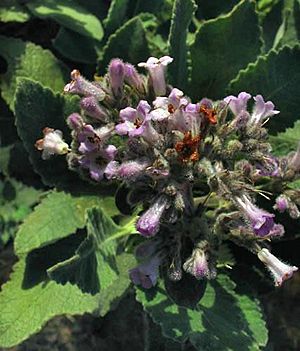Thickleaf yerba santa facts for kids
Quick facts for kids Thickleaf yerba santa |
|
|---|---|
 |
|
| Scientific classification | |
| Genus: |
Eriodictyon
|
| Species: |
crassifolium
|
Eriodictyon crassifolium, also known as thickleaf yerba santa, is a type of shrub that belongs to the borage family. The name "Crassifolium" comes from Latin and means "thick leaf," which describes its leaves well!
Contents
What Does Thickleaf Yerba Santa Look Like?
Thickleaf yerba santa is a shrub that can grow from one to three meters (about 3 to 10 feet) tall. It often feels hairy or woolly to the touch.
Leaves and Flowers
Its leaves can be quite large, up to 17 centimeters (about 7 inches) long and 6 centimeters (about 2.5 inches) wide. They are a dark green color. Sometimes, the edges of the leaves have small teeth. The underside of the leaf is usually very hairy, while the top might be less hairy and feel more tough or leathery.
When the plant blooms, it produces clusters of pretty, bell-shaped lavender flowers. These flowers grow together in what is called an inflorescence. The stems of the plant are woody and branch out.
How to Tell It Apart from Other Plants
It's easy to mix up thickleaf yerba santa with other plants that look similar. Two plants that are often confused with it are E. trichocalyx and E. californicum, which are also types of yerba santa.
However, it's very important to know the difference between thickleaf yerba santa and a plant called E. parryi, also known as poodle-dog bush. This is because E. parryi is a poisonous plant that can cause a very bad skin rash.
Where Poodle-Dog Bush Grows
Poodle-dog bush often grows in the same areas as thickleaf yerba santa, especially in places where the land has been disturbed, like after a wildfire. If you want to learn more about how to tell these plants apart, you can find information in articles about E. parryi.
Where Does Thickleaf Yerba Santa Grow?
Thickleaf yerba santa is a plant that is endemic to California. This means it naturally grows only in California and nowhere else in the world!
Its Natural Home
You can find it in several different natural areas, including chaparral. It grows in the hills and mountains near the coast and further inland. It is mostly found in the southern part of California, south of the Santa Barbara and San Luis Obispo county line. It spreads from the coast through the Coast Ranges and Transverse Ranges.
Where It Likes to Live
This plant prefers dry slopes and areas called washes (places where water flows during heavy rain). It's very common to see it growing along roadsides. You might also find it on flat-topped hills called mesas or in river bottoms. If an area has been disturbed, the plant can grow back from its roots.
In the Transverse Ranges, thickleaf yerba santa can grow at elevations up to 2500 meters (about 8,000 feet). However, it is more common below 1800 meters (about 6,000 feet). Plants growing at lower elevations can be up to 2 meters tall and have many leaves.
What Are the Uses of Thickleaf Yerba Santa?
For a long time, thickleaf yerba santa has been used by people for different purposes.
Traditional Uses
The Chumash people, who are a Native American group, traditionally used this plant. They used it to help keep their airways open, which made it easier to breathe.
How It Can Be Used Today
The leaves of thickleaf yerba santa can be chewed like gum. They can also be made into a tea, but this tea can taste quite bitter. Some people also find that the plant has an unpleasant smell.
Important Safety Note
If you are thinking about gathering the leaves to use, it is extremely important to be absolutely sure you have the correct plant. You must be able to accurately tell it apart from the poisonous E. parryi (poodle-dog bush) to stay safe.

